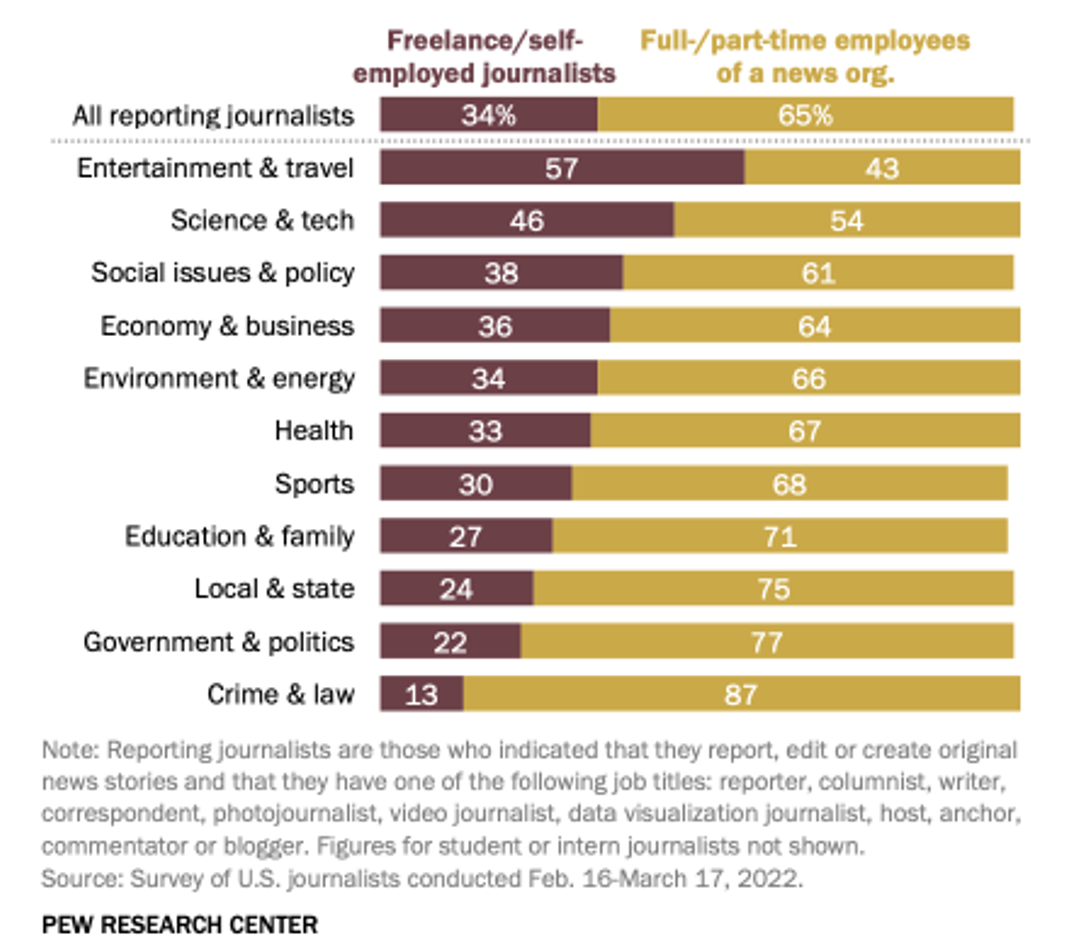Freelance journalists are often overlooked but can be valuable contacts, especially as the in-house journalist pool shrinks.
One of the first facts I learned when starting my career in communications was that journalists get an overwhelming number of email pitches. For every reporter, there are 6.2 PR pros, actively pitching story ideas and press releases.
Some repeatedly send follow-up emails to journalists, while others resort to cold calling, which isn’t always effective. Breaking through that noise, even with a great pitch, becomes challenging. However, when working with clients I noticed there’s a sizeable subset of writers that many seem to disregard when planning campaigns and media outreach: freelance writers.
In recent years, as the number of in-house reporters declined, freelancers have seen rapid growth.
Pew Research Center surveyed around 12,000 US-based journalists and found 34% to be freelance/self-employed, and the number is rising. For some sectors, there are now more freelancers than in-house reporters.

The combination of the rise in remote work, reduced editorial staff, and a high demand for content have all played a role in this trend.
But despite this growth in numbers, we hear from our freelancer contacts that they still often get left out of networking opportunities or PR campaigns.
One of the benefits of adding freelancers to your media list is the wider reach these they tend to have. Freelancers almost always work with multiple publications—and often global ones—resulting in a strong online presence and an even larger potential audience.
For instance, Mallika Mitra is a well-known journalist who covers business and finance topics. She reported for Money for more than three years before becoming a freelance reporter and editor. Since then, she has written for The Wall Street Journal, Business Insider, and The Bond Buyer. This means there’s a good chance that an interview with her may end up appearing in multiple top-tier publications.
In many cases, journalists also represent a brand of their own, by hosting successful podcasts, writing newsletters, and even starting their own news publications. Casey Newton is one of them. After leaving The Verge, Casey created his newsletter on Substack called Platformer and as of January 2024, it has over 170,000 subscribers to the free edition with the website receiving over 220,000 unique monthly visitors. In 2022, Casey also began co-hosting a weekly technology podcast, Hard Fork for the New York Times with technology columnist, Kevin Roose.
Founder of Scraper API, Daniel Ni created the TLDR newsletter that quickly became popular in the news media. With over 1 million subscribers and 125,000 followers on Twitter, the newsletter provides daily summaries of stories about technology, startups, and programming. Hence, appearing in their stories can be as valuable as appearing in a top-tier publication.
So how do you go about building relationships with freelancers? New York City is one of the most popular places for these professionals, as they expect to earn more and build a stronger network than in other cities.
An effective way to meet freelance writers (and even full-time journalists) is by attending networking events. Companies such as OnePitch often organize events and invite journalists and PR pros to connect and expand their sources. There are also several online directories and platforms available to research and identify a freelancer with a relevant reporting background.
Help a Reporter Out (HARO) can be an effective “matchmaker” for finding a freelancer that covers your desired beat. Keep in mind that journalists on HARO most often look for specific written commentaries on stories with tight deadlines so it is less likely they’d be interested in intro meetings. Finally, the communications agency you work with will likely have an up-to-date list of freelance contacts.
Similarly, interns and fellows can be as valuable to your brand as full-time reporters. Some communications experts tend to stay away from interns, assuming they are inexperienced, won’t be working on a story, or may do poor reporting.
At The Wall Street Journal and The New York Times, we have seen interns lead stories under the guidance of their experienced colleagues. Interns and fellows are both at the early stage of their careers and are always looking to expand their network to impress their bosses. Building a relationship with someone early in their career and helping them expand their source base makes it likely for them to come back to you later in their careers.
David Asatryan is a senior account executive in New York

